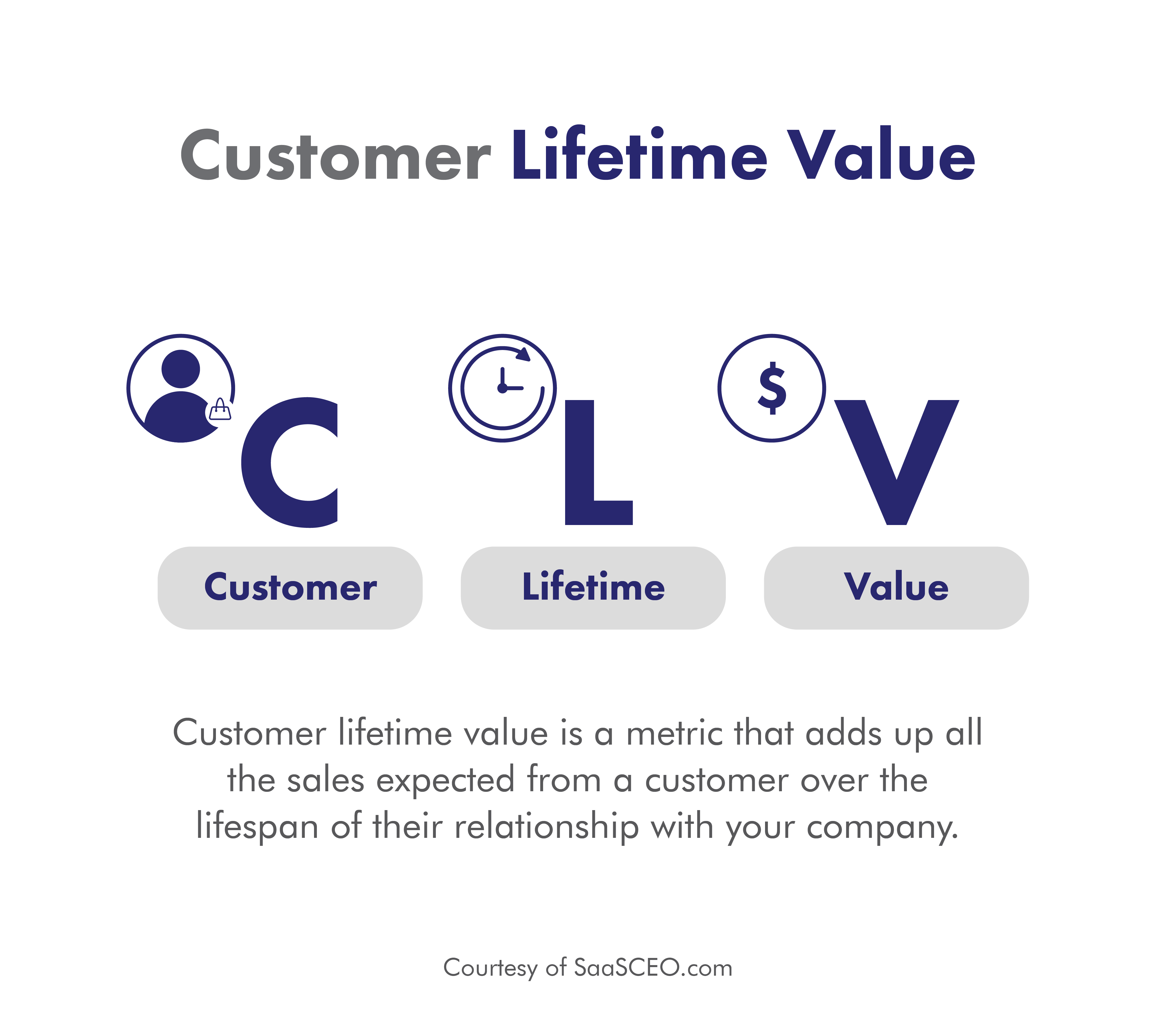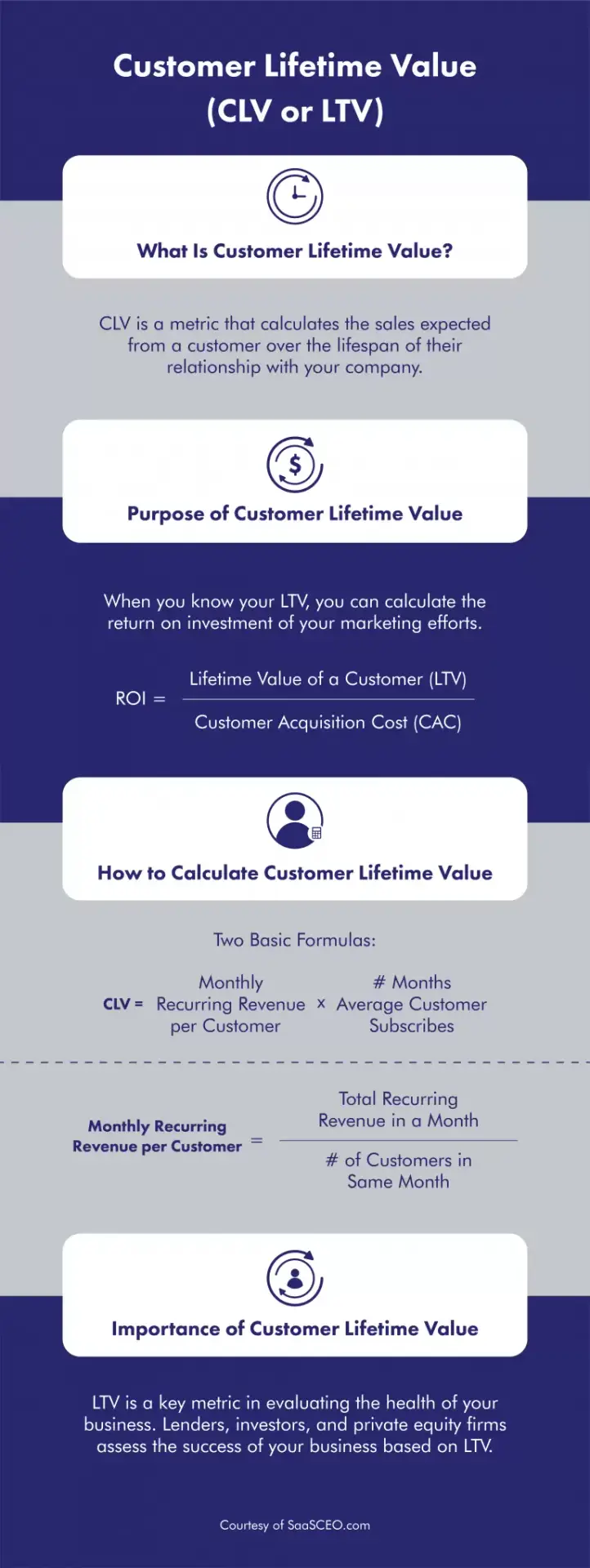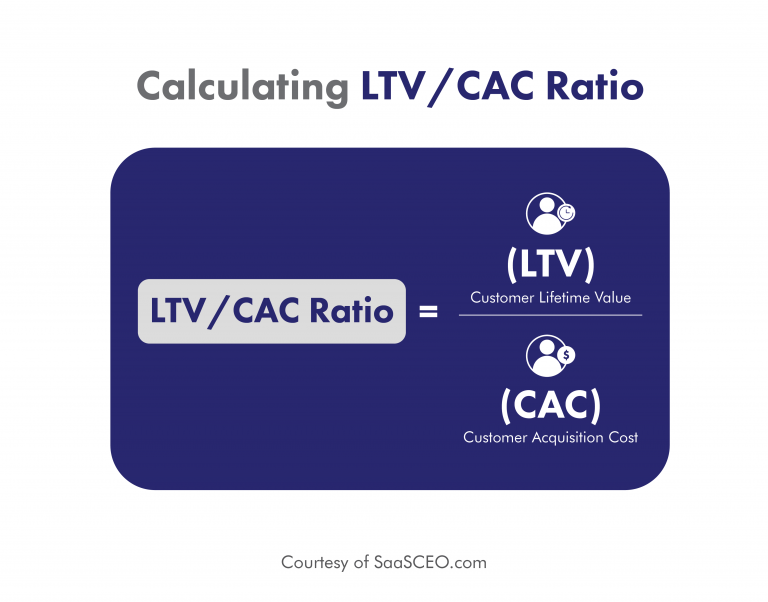
Customer lifetime value is a metric that adds up all the sales expected from a customer over the lifespan of their relationship with your company. This metric is abbreviated as CLV or LTV. CLV is extremely useful in businesses that have subscription billing models and/or high repeat-purchase rates.
What Is LTV in SaaS?

In SaaS, lifetime value is an essential metric for measuring revenue that comes in over time. As many SaaS businesses use subscription billing models or have repeat purchases, the timing aspect of revenue is an important factor in assessing the health of the business.
To fully appreciate why SaaS and other recurring-revenue-based companies use LTV, it makes sense to look at a simpler business that focuses on one-time sales.
Let’s assume you have a business that sells a widget for $100.
Scenario #1: The Economics of a One-Time Purchase Business
The economics of such a business are very simple.
Price: $100
Cost of Goods Sold: -$50
Customer Acquisition Costs: -$60
——————————————————————
Gross Profit Contribution: -$10
If you sell a widget at $100, and it costs you $50 to make the widget and $60 in sales and marketing expenses to get a customer, then your effective gross profit (a.k.a. profit before your operating expenses) is a $10 loss.
If customers never purchase more than one time, this is a money-losing business. For every $100 in sales, you lose $10 even before paying out operating expenses.
A business where customers only make one-time purchases, don’t buy on a subscription billing model, and don’t make repeat purchases is a lousy business. The more you sell, the more money you lose.
Clearly, this is an unprofitable business.
In this example, we would say the lifetime value of a customer is $100.
All customers buy only once, they pay $100. Therefore, during the entire lifespan of the customer being with your company, they spend only $100.
Scenario #2: The Economics of a Two-Time Purchase Business
Now let’s change the scenario to one in which, instead of making one purchase from a vendor, the customer makes two purchases: one initial sale and one repeat sale.
First, let’s look at the profitability of each sale:
First Sale
Price: $100
Cost of Goods Sold: -$50
Customer Acquisition Costs: -$60
——————————————————————
Gross Profit Contribution: -$10
Second Sale
Price: $100
Cost of Goods Sold: -$50
Customer Acquisition Costs: $0
——————————————————————
Gross Profit Contribution: $50
If we look at the difference in economics between the first and second sales, we see that they’re wildly different.
The first sale loses $10 while the second sale makes $50.
Intuitively, this scenario is much more attractive than the business with customers who only make one-time purchases with no repeat purchases. That much is clear.
Also, this is reflected in the customer lifetime value calculation.
CLV = Price of First Sale + Price of Second Sale
CLV = $100 + $100 = $200
In this scenario, customers spend an aggregate of $200 over the course of their relationship with your company.
Now let’s look at our final scenario.
Scenario #3: The Economics of a Subscription Business
In this scenario, let’s say the customer signs up for a monthly subscription. The subscription costs $100 per month. On average, a customer remains a subscriber for 60 months (five years) before they quit. Let’s look at the economics.
Economics: Month 1
Price: $100
Cost of Goods Sold: -$50
Customer Acquisition Costs: -$60
——————————————————————
Gross Profit Contribution: -$10
Economics: Months 2 – 60
Price: $100
Cost of Goods Sold: -$50
Customer Acquisition Costs: $0
——————————————————————
Gross Profit Contribution: $50
In this scenario, the customer pays you $100 in Month 1, the same in Month 2, all the way through Month 60 (end of year five). Intuitively, it’s far better to receive a $100 payment 60 times in a row than just one or two times.
As you might have guessed, the CLV also reflects this intuition.
In this case, the CLV is equal to all the payments the customer pays you over the life of the subscription relationship.
CLV = $100 x 60 months = $6,000
Summary:
| $ Price x Purchases | Customer Lifetime Value | |
|---|---|---|
| Scenario #1: One-Time Purchase | $100 x 1 | $100 |
| Scenario #2: Two-Time Purchase | $100 x 2 | $200 |
| Scenario #3: 60-Month Subscription | $100 x 60 | $6,000 |
As you can see, Scenario 3 is intuitively far more financially attractive.
Customer lifetime value is useful to capture revenues received over time. If we didn’t have this metric and solely made decisions based on the profitability of the first sale, we would erroneously conclude that the business in Scenario 3 is an unprofitable business.
Ultimately, the purpose of metrics is to make better decisions. Generally, you want to continue to do things that make you money and stop doing things that don’t. When revenue comes in over time, the CLV metric helps capture the timing aspect of revenues so that you can make better-informed decisions.
Why Timing of Revenue Matters
In a simple business, the math is easy. You take your revenues (which are known), you subtract your costs (which are also known), and you know your profitability. These are the basic profit and loss economics that any kid with a lemonade stand eventually figures out.
However, when you receive revenue over time, you switch from profit and loss math to return on investment (ROI) math. In this context, customer lifetime value is the return. The investment that’s made to get that return is the customer acquisition cost. For SaaS and recurring-revenue businesses, instead of:
ROI = Return / Investment
ROI = Lifetime Value of a Customer (LTV) / Customer Acquisition Cost (CAC)
This is known as the CAC/LTV ratio.
The purpose of the CAC/LTV ratio — or more generally, figuring out the ROI — is to determine whether a particular investment is worth making.
If you have $1 to invest and it can return $3, that’s good. If it can return $5, that’s even better. If that $1 investment can return a whopping $10, that’s stellar.
In the SaaS business, these kinds of decisions can involve lead generation sources, sales channels, vertical markets, geographic markets, and customer segments.
For example, in working with many SaaS founder CEOs, I’m often asked which is better: inbound sales (generating an inbound lead via marketing and using sales to call back the prospects who inquire) or outbound sales (having sales cold call a prospect to see if they might be interested). This is often framed as a philosophical debate.
All debates in a well-run SaaS company can be solved with… math.
If you invest $1 to acquire a customer via marketing (a.k.a. inbound sales), and it produces $5 in lifetime value, that’s a very useful metric to know.
If you also invest $1 to acquire a customer via cold call (a.k.a. outbound sales), and it produces $3 in lifetime value, that’s also a very useful metric to know.
All else being equal, in this example, you’d want to do more inbound marketing.
However, all efforts to generate sales will reach points of diminishing returns. For example, as you invest more in inbound marketing, perhaps the return on those investments starts to decline. Instead of $1 in marketing producing $5 in customer lifetime value, it now produces $2.50. At this point, you see the effectiveness of inbound marking declining versus outbound sales. That’s the time to expand investments in outbound sales.
Why Is the CAC/LTV Ratio Important?

The CAC/LTV ratio can be used to help you make informed decisions for changes in your business — from new markets to new sales strategies and so on.
You can apply this kind of thinking to targeting small business customers versus middle-market ones.
Apply it to selling via an automated sales process (e.g., eCommerce, self-service sales processes, and product-led marketing) versus a human sales force.
You can apply the same reasoning to customers who buy one SaaS module you offer versus another.
You can and should apply it to customers who buy on a month-to-month contract versus an annual contract versus a three-year contract.
When you know the customer acquisition cost and the customer lifetime value it generates, you get a menu of options in which you can potentially invest further.
As discussed in my book Extreme Revenue Growth, much of the transition from founder to CEO has to do with the professional CEO thinking more like an investor. In many ways, a professional CEO is an allocator of people resources and financial resources.
Obviously, this is far easier to do when you know what the historical ROI has been for various previous investments. This is why the lifetime value metric is so important to know… because without knowing the return, you can’t calculate ROI… and if you don’t know what the ROI is, then you’re investing blindly.
For now, let’s figure out how to calculate customer lifetime value, both conceptually and in the real world.
How Do You Calculate Lifetime Value of a Customer in SaaS
Conceptually, the way to calculate CLV is to add up all the payments received from a customer over the lifespan of their relationship with your business. While this is theoretically correct, there are some practical obstacles.
If you’re a new company and have only been in business for a month, in practice, you don’t really know what your ultimate CLV will be. You simply don’t have enough data.
In practice, SaaS and other recurring-revenue companies use formulas to estimate CLV. The math isn’t perfect, but it’s sufficiently correct to figure out if the ROI (a.k.a. CAC/LTV ratio) is high enough to be worth pursuing or so low that you have a problem you need to address.
When you don’t have years of subscription renewal data to accurately determine customer lifetime value, the reasonable shortcut approach is to use the following two formulas:
"Basic" Customer Lifetime Value = Monthly Recurring Revenue per Customer * # of Months Avg Customer Subscribes
Notes:
- The churn rate should be expressed as a decimal, so a 2% churn rate = 0.02
- The LTV can also be calculated using annual recurring revenue and the # of years that customers subscribe; the key is that the unit of time for both the numerator and denominator must be the same.
Of these two metrics, the monthly recurring revenue is easy to determine. If you have only one subscription plan, it’s the price listed on your website. If you have multiple plans, then it’s the total recurring.
Monthly Recurring Revenue per Customer = Total Recurring Revenue in a Month / # of Customers in the Same Month
# of Months Avg Customer Subscribes = 1 / Churn Rate
Note: the churn rate should be expressed as a decimal, so a 1% churn rate = 0.01. If the churn rate is 100%, you use 1.00.
To prove the formula, let’s look at some simple cases to grasp the intuition behind it.
Case #1: 100% Monthly Churn
Let’s say you have a terrible SaaS product. Every time you get a customer, they quit after one month. You have a 100% churn rate. Intuitively, we know that customers subscribe for one month before they quit. Now let’s look at the formula:
# Months Customer Subscribes = 1/1.00 = 1 month
Case #2: 50% Monthly Churn
In this scenario, we lose half our customers each month. Intuitively, we grasp that customers stick around for two months before they churn out. The formula reaches the same conclusion.
# Months Customer Subscribes = 1/0.50 = 2 months
You can see through these examples that this formula matches our intuitive grasp. As we get beyond the simplest cases, we can rely on this formula to help us.
Case #3: 2% Monthly Churn
# Months Customer Subscribes = 1/0.02 = 50 months
Going Beyond Basic Customer Lifetime Value
Now that we understand basic customer lifetime value, let’s go through variations of this basic concept and formula that are utilized as a SaaS company’s revenue streams get more multi-faceted and when there’s better data to make more refined calculations.
Variation #1: Customers Have Transaction Fees, Not Just Subscription Fees
Customer Lifetime Value = Average Revenue per Customer per Month * # of Months
Variation #2: Account Churn and Gross Revenue Churn Differ
There are a few different ways to look at churn. Since the customer lifetime value calculation is based on churn, the LTV calculation will vary depending on which definition of churn you’re using.
Here are two different definitions:
Account Churn (Also Known as Logo Churn): Account churn looks at how many customers you have at the start of a period (such as a month) versus how many you have at the end of the period. Let’s say you have 100 customers at the start of the month, and you lose ten customers by the end of the month. In this case, your account churn is 10% per month. 10 lost customers/100 starting customers = 10%.
Gross Revenue Churn: Sometimes, the average monthly spending of customers who stay subscribed differs from those who churn. In these situations, it’s more useful to calculate the percentage of revenues lost due to churn rather than the number of customer accounts lost. Let’s say you have $100,000 in recurring revenue at the start of the month. At the end of the month, you’ve lost $1,000 in recurring revenue. In this case, you have 1% gross revenue churn (regardless of how many accounts or logos you lost).
When there’s sufficient data, it’s preferable to use gross revenue churn as the definition of churn you use in calculating customer lifetime value.
Variation #3: Calculating Customer Lifetime Value by Customer Segment
In my work with SaaS companies, one of the big opportunities comes from calculating LTV by customer segment rather than only for the customer base as a whole. This is only possible if you separate your customers into different groupings or segments and separately track churn and monthly revenue for customers within each segment. This enables you to calculate LTV for the average customer in the segment.
In the 23 years since I’ve been working in SaaS, 100% of the time, I’ve found significant variances across different customer segments for lifetime value. Stated differently, not all customers are created equally… some are a lot more desirable than others. By calculating and tracking customer lifetime value by segment, you can identify which segments are more attractive than others.
Here are some examples of how to segment your customers:
- Vertical industry
- Annual contract value
- Length of contract term (one month, one year, three years)
- Geography
- Job title of primary contact
- Source of lead
- Sales channel (partner vs. in-house sales team, inbound vs. outbound sales)
What Is a Good Customer Lifetime Value in SaaS?
Customer lifetime value for a SaaS business will vary enormously by industry, customer type (consumer vs. B2B), and company size (Fortune 500 vs. freelance contractor). In general, higher is better than lower.
A more useful way to determine a good LTV for your business is to look at benchmarks for the average lifespan of customers in various markets (measured in months). Then, multiply that by your monthly recurring revenue per customer.
In B2B SaaS companies targeting small businesses, 24-month lifespans are typical. A good lifespan here would be 48 months or more. Enterprise SaaS companies often see customer lifespans of 120 months, but over 250 months is considered good. For B2C SaaS companies, the average lifespan of 12 months is typical, and those over 24 months are good.
The Importance of Customer Lifetime Value
I cannot overstate the importance of customer lifetime value. It is one of the key metrics to evaluate the health of a business. For improving and monitoring performance, it’s a key metric. It’s also a metric used by lenders, investors, and private equity firms to quickly assess the financial performance of a business. If you tell a savvy outsider that you have a company that generates $10M+ in annual recurring revenue, has a 100%+ year-over-year growth rate, and the LTV is eight times higher than the CAC, I guarantee that you’ll get that investor’s attention, and they’ll want to know more.
In a follow-up article, I discuss the nuances of calculating and using CAC — the metric to which we compare lifetime customer value. It’s the investment side of the return on investment when it comes to acquiring customers in SaaS businesses. In addition, I’ll be writing a comprehensive guide on various ways to increase customer lifetime value.

Pingback: Revenue Expansion: Decoding the Concept – CPA Growth Partner
Pingback: Qual vida útil de um cliente SaaS? - Lui von Holleben
Pingback: Startup Company Guide To SaaS Customer Success - Virtua Solutions Outsourcing